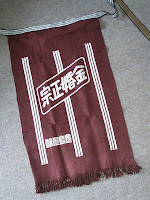Hello, everyone. I feel I drink sake so much lately and I need some workout.
So, I walked a bit long walking trail, which starts at the JR Hamura Station, descends the Oterazaka Slope, reaches the diversion weir of Tamagawajosui Water Supply, and then, walks to Tamura Syuzoujou along the water supply channel (See the map at the end of this article).
The Tamagawajosui Water Supply Channel starts at the diversion weir of Tamagawajosui Water Supply that takes water from Tama River. The channel runs as long as about 43 kilometers through many cities including Fussa, Kodaira, Musashino Cities and reaches the Shinjuku Ward.
Walk from the from the west exit of the Hamura Station southwestward. About a five-minute walk from the station brings you to the beginning point of the Oterazaka Slope. There is a water place for horses some midway of the slope. There is a fountain in this place and people in the old days fed water to their horses here.


Beside the slope, there is the Inari Shrine. Mountains in the Okutama area can be seen from the place where this shrine stands.


Return to the slope and walk down the place and take the left before the slope ends. At this corner, there is Zenrinji Temple.
The slope name Oterazaka contains the word "tera," which means a temple. Actually, the name of the slope derived from this temple.

Seeing Kitaura Liquor Shop on your left and Japanese confectioner Yamadaya on your right, go straight to reach the Old Okutama Kaido Street.
By the way, I often buy sake from this liquor shop Kitaura.


The Tamagawajosui Water Supply Channel flows along the Old Okutama Kaido Street around here.

Walk across the bridge over the channel, then take the right, and walk toward the upper reaches of the channel for about a minute or so. Then, you'll see the statues of the Tamagawa Brothers. They were received the order that they supervise the construction of the channel, started the construction works in April of 1653, and completed the works in the next year. It took only a year and a few months for them to complete the works! This is an incredible speed compared of the sluggish progress of present-day public works.

The diversion weir of the channel is just several tens meters upstream from the statues.


You'll find an interesting thing at the point close to the weir. This is called
ushiwaku, which is used for flood control. In the old days, they sunk many
ushiwakus in the river for preventing flood disasters.

Well, walk down the walk trail along the channel from here.
Having been taken a great amount of water at the weir, Tama River looks a kind of miserable.

In the cherry blossom season, there are many outdoor stalls around the place of the photo on the left. The photo on the right shows the third water gate of the channel. From this gate, water is supplied to other reservoirs.


Downstream of the third gate, amount of the water flow is decreased as a lot of water has been taken away.


There are mulberry trees on the bank. They have a lot of mulberries at this time of the year.


The walk tail becomes narrow. I wonder the place around here is already in Fussa City?


There are benches in the Fussa Kami Josui Park. It may be a nice place to take a rest.


Walk further and further and you will come to a place where you see houses. Finally, you will reach a T-junction and you cannot go straight any further.


See the right at this intersection and you'll find a chimney ahead. This is the chimney of the very brewery at the goal point of this walkway.

Now, you have finally reached Tamura Syuzoujou. The buildings on the premises are quite admirable!


==The Map of the walkway==
より大きな地図で 酒蔵のある散歩道(田村酒造場) を表示Today's SakeKasen Junmaishu Tamagawajosui (Tamura Syuzoujou)Light taste, easy to drink!





















































